|
Table of Contents for
[Session7]Study Case in IT Field (1)
Study Case in IT Field (1)
This Session's Task (Assignment)
|
Special
Research I
 Session
7: Study Case in IT Field (1) (Lecturer: Hiroshi Nakano) Session
7: Study Case in IT Field (1) (Lecturer: Hiroshi Nakano)
[Study Case]
I would like to
introduce studies, among other study examples I have supervised so far,
that are more or less related to educational supports using IT. However,
there is no need whatsoever for you to feel obliged to make your study
connected to these examples.
An
example of research & development related to Instructional Design
Based e-Learning Support. (2007-2008)
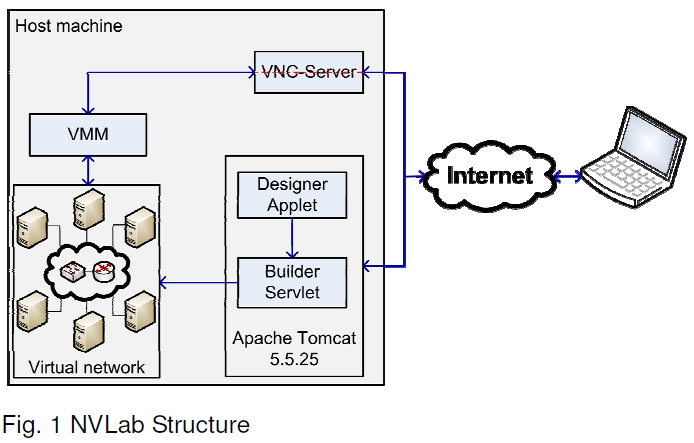 Mr. Wannous is a
government-sponsored foreign student. He started master program of
Computer Science and Electrical Engineering in Graduate school of
Science and Technology from 2007, and he continues his study in PhD
program. He has some experiences of working in the development section
of a big company for several years. Mr. Wannous is a
government-sponsored foreign student. He started master program of
Computer Science and Electrical Engineering in Graduate school of
Science and Technology from 2007, and he continues his study in PhD
program. He has some experiences of working in the development section
of a big company for several years.
With the wide spread of e-learning platforms among educational and
training-delivery organizations, it is necessary to provide not only
online documents and media resources, but also high quality online
practice-acquiring facilities where learners can apply what they have
studied. This is particularly important in ICT field where practice is a
major part of the learning process. ICT graduates are supposed to have a
certain level of hands-on experience in dealing with network devices,
designing, and troubleshooting a network scenario. Addressing this issue
he introduced NVLab, a web-based environment designed to provides
learners with tools to: draw a Computer Network diagram and save it on
the server. realize this diagram on the server. remotely connect to the
machine hosting the network. configure the network devices and test the
functionality of their design. NVLab makes use of two technologies:
Virtualization (Xen) and Virtual Network Computing (VNC) to achieve the
goal. Virtualization is used for creating the network devices included
in the diagram the learner has produced. Each device is realized as a
Virtual Machine (VM) that will run an Operating System instance, and the
connection between these VMs is done through software solution provided
by the Virtualization layer. On the other hand, Virtual Network
Computing enables learners to remotely access the NVLab server through
their web browsers to configure and test the functionality of the
network they designed.
He presented a poster at some Japanese academic meetings [1] and at an
international conference [2].
- Muhammad WANNOUS,
Hiroshi NAKANO and Kenichi SUGITANI, Implementing Virtualization and
Virtual Network Computing in NVLab, a Web-Based Computer Networks
Laboratory, 33rd Annual Conf. of Japanese Society for Information and
Systems in Education, pp.478-479 (2008).
- Muhammad
Wannous, Hiroshi Nakano, Toshihiro Kita and Kenichi Sugitani,
Information Technology Based Higher Education and Training (ITHET
2007), Kumamoto, Japan, July 10-13, pp.196-199 (2007)
An
example of research & development related to Instructional Design
Based e-Learning Support. (2008)
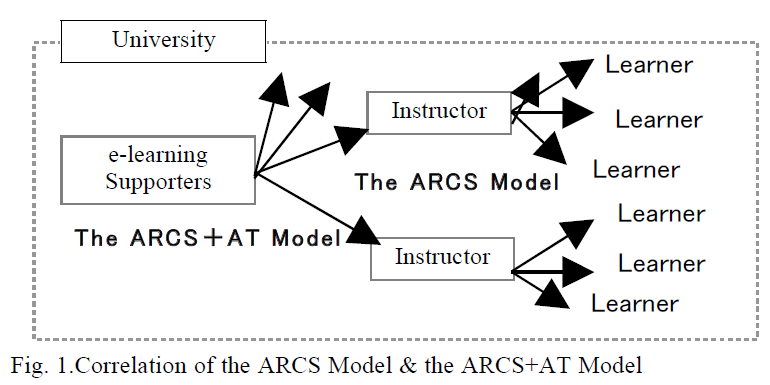 Mr. Nakajima is a
distance student of Graduate School of Instructional Systems. He has
been working as an officer or administrator in a university's computer
center. He is really interested in Instructional Design, and tried to
apply the ARCS model to help e-Learning supporters. Because
Instructional Design is not my field, my contribution is indirect. Mr. Nakajima is a
distance student of Graduate School of Instructional Systems. He has
been working as an officer or administrator in a university's computer
center. He is really interested in Instructional Design, and tried to
apply the ARCS model to help e-Learning supporters. Because
Instructional Design is not my field, my contribution is indirect.
It is true that many Japanese universities are diligently working on
activities to develop e-learning and are having difficulty in achieving
efficient and effective outcomes compared to a university's own
expectation. he founds that it is better to focus on a person (or a
section) in charge of supporting instructors and the university's
e-learning development.
The role of that person is important whether or not the one is a
professor or staff. The one will be able to succeed when the person has
a method of checking what to do concretely and clearly to provide proper
information and assistance for achieving better outcomes in e-learning.
In this study, we propose a checklist for e-learning supporters based on
ID theories, especially on the ARCS+AT Model, which is based on the ARCS
Model proposed by Prof. Keller.
The research is aimed to prove the effectiveness of the ARCS+AT model
and the checklist at the actual situation of any university and also to
improve its quality by analyzing the feedbacks from some universities
like the results of the test use of the checklist, comments to the
checklist and the answers to the questionnaire.
He is convinced that this study will develop ARCS+AT model and the
checklist and the model will contribute to Japanese Higher Education in
the near future.
He presented a poster at the 6th Kumamoto University Forum in Indonesia
[1].
- Koji
Nakajima, Hiroshi Nakano, Fujio Ohmori, Katsuaki Suzuki and Toshihiro
Kita, An Instructional Design Based Checklist for e-Learning Supporters
in Higher Education, The 6th Kumamoto University Forum, Poster session,
Surabaya, Indonesia, Nov, 5-6, 2008.
An
example of research & development related to citizen e-Learning
community. (2007-2008)
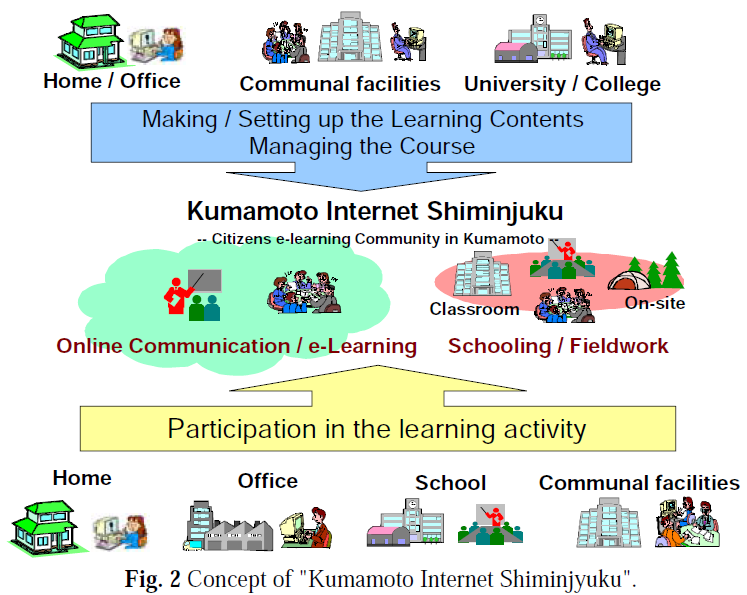 Mr.
Murashima is a distance student of Graduate School of Instructional
Systems. He has been working as a system engineer in a big company's
blanch in Kumamoto city, and is related to the network system in
Kumamoto university. He, therefore, we can meet easier than other
distance students. We started "Kumamoto Internet Shiminjuku" -- Citizen
e-learning community in Kumamoto from 2005, and he is interested in
automated system for making e-Learning contents based on Instructional
Design. Mr.
Murashima is a distance student of Graduate School of Instructional
Systems. He has been working as a system engineer in a big company's
blanch in Kumamoto city, and is related to the network system in
Kumamoto university. He, therefore, we can meet easier than other
distance students. We started "Kumamoto Internet Shiminjuku" -- Citizen
e-learning community in Kumamoto from 2005, and he is interested in
automated system for making e-Learning contents based on Instructional
Design.
Since lifelong learning has become important and information and
communication technology using the Internet has been ubiquitous today,
he established "Kumamoto Internet Shiminjuku" -- Citizen e-learning
community in Kumamoto, Japan with some members including me, which is a
lifelong e-learning project by citizens' group. This article shows the
example of practicing e-learning in "Kumamoto Internet Shiminjuku" and
refers to the meaning and the possibility of elearning use for lifelong
learning. Moreover, in order to make elearning courses more effective
and efficient, he is studying and applying instructional design theories
for citizen e-learning.
He did an oral presentation at the 6th Kumamoto University Forum in
Indonesia [1].
-
Ryoichi MURASHIMA, Hiroshi NAKANO, Toshihiro KITA, Shiro KITAMURA,
Junko NEMOTO, Katsuaki SUZUKI and Tsuyoshi USAGAWA, Advantages of
e-Learning for Citizen Learning Community - A Case of "Kumamoto
Internet Shiminjuku" -, The 6th Kumamoto University Forum, Oral
session, Surabaya, Indonesia, Nov, 5-6, 2008.
An
example of research & development related to Learning Object Model
(2007)
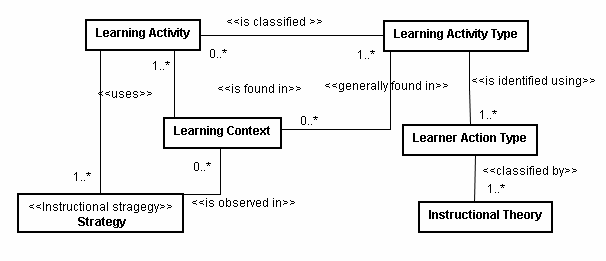 Mr. Toyonaga was a
distance student of the inaugural class of Graduate School of
Instructional Systems. He has been working as an chief ICT instructor in
big company for long yeas, and he already had many experience of
instructional design when he joined our program. Following study is part
of his master thesis where took the initiative with my small
contributions. Actually, he knows this field much better than me. Mr. Toyonaga was a
distance student of the inaugural class of Graduate School of
Instructional Systems. He has been working as an chief ICT instructor in
big company for long yeas, and he already had many experience of
instructional design when he joined our program. Following study is part
of his master thesis where took the initiative with my small
contributions. Actually, he knows this field much better than me.
Instructional designer must identify specific objectives with meaningful
teaching and learning strategies from learners' perspective. Underlying
models of preceding researches do not have sufficient pedagogical
components such as instructional strategy classification to describe our
unit of learning. To solve this problem he considered additional
elements with existing meta-model. The purpose of this study is to
describe an extension for learning object meta-model specific to
learning activities, to help instructional designers select strategy in
various situations where they are working with existing assets.
He presented the work in English by himself in an international
conference [1].
- Masato
Toyonaga, Hiroshi Nakano, Norio Iriguchi and Katsuaki Suzuki,
Information Technology Based Higher Education and Training (ITHET
2007), Kumamoto, Japan, July 10-13, pp.103-108 (2007)
An
example of research & development related to IT support using single
sign-on and portal (2006)
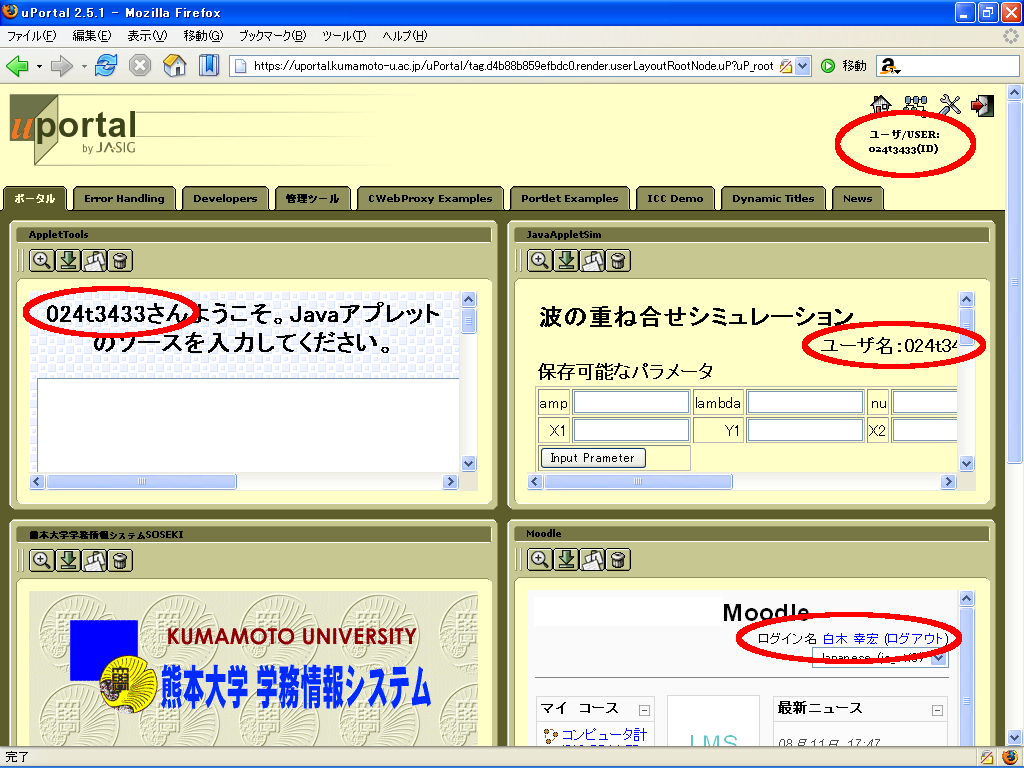 Mr.Shiraki and Mr.
Sugao actually are two of the graduates from 2005. Therefore this is not
the introduction of a master's thesis, but the introduction of graduate
thesis. I would like to introduce these cases simply because there have
not been similar studies carried out as a master's degree. Mr.Shiraki and Mr.
Sugao actually are two of the graduates from 2005. Therefore this is not
the introduction of a master's thesis, but the introduction of graduate
thesis. I would like to introduce these cases simply because there have
not been similar studies carried out as a master's degree.
Both students studied the possibilities of portal (uPortal) and single
sign-on (CAS)
in the area of online education. Although both applications are
open-source Web applications, as long as a system which is compatible
with this combination is used, once authenticated, it became possible to
access the whole system without further authentication. Because of this,
it became possible, as shown in the image, to bring in or make a link to
a variety of systems on the portal site.
Based on this, they developed a tool to support the learning of
Java programming and a tool to record parameters of the simulation
material and confirmed that it is possible to display them not only on
uPortal but on Moodle and WebCT as well, in such way that they look as
if they are functions integrated with the site.
After they graduated from the university, I put together their work and
presented it at the CMS study meeting for them [1].
- Y. Shiraki, T.
Sugao, H. Nakano, and T. Kita, “Development of a Learning Support Tool
under CAS Integrated Authentication”, the second CMS study meeting in
Nagoya, Information Processing Society of Japan, 2006 (Japanese only, except
abstract)
An
example of research & development related to a LMS module
(2005-2006)
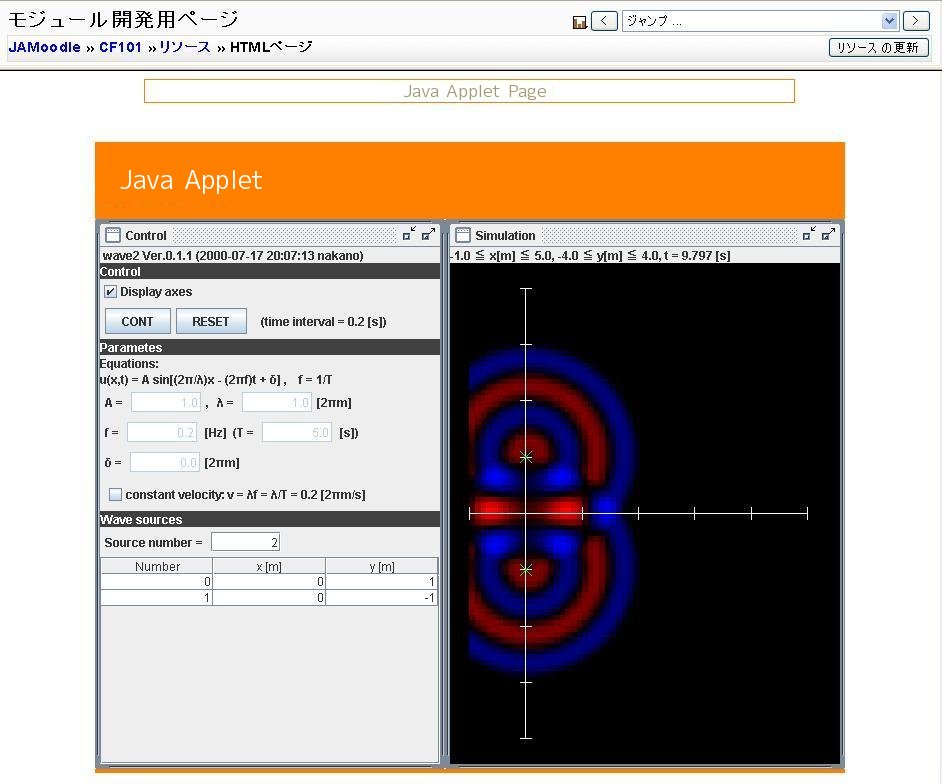 Mr.Matsuo, as a
support module for simulation program development on Moodle, developed a module
for Moodle, which can publish the Java applet as material on the Moodle
by simply copying/pasting etc. the source code of the Java applet. By
using this module, you can use, as an instructional material, the same
Java applet material on Moodle by simply pasting the source of the Java
applet on the Internet, even if you do not have Java development
environment on your PC. In addition, you can also do some customization
because you can edit the source online.
Mr.Matsuo, as a
support module for simulation program development on Moodle, developed a module
for Moodle, which can publish the Java applet as material on the Moodle
by simply copying/pasting etc. the source code of the Java applet. By
using this module, you can use, as an instructional material, the same
Java applet material on Moodle by simply pasting the source of the Java
applet on the Internet, even if you do not have Java development
environment on your PC. In addition, you can also do some customization
because you can edit the source online.
Although he was about to graduate, he himself presented his paper at the
Educational Frontier Technical Meeting of the Institute of Electrical
Engineers of Japan [1].
- D. Matsuo, S.
Tanaka, T. Kita and Nakano, “Moodle-compatible Module to Give Support
to Java Applet Production”, Educational Frontier Technical Meeting, the
Institute of Electrical Engineers of Japan, FIE-05-33, 2006 (Japanese
only, except abstract)
An
example of research & development related to instructional effects
of on-line tests (2005)
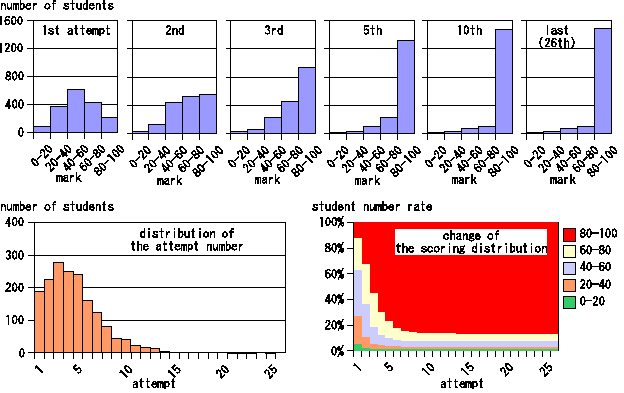 This study is an
important work declaring effectiveness of online tests. It therefore is
introduced in spite of not a student's work. Kumamoto University
implements basic courses of information technologies as required
subjects of all faculties from 2002. They can be assumed as large-scale
courses because there are approximately 1,800 learners respectively.
They are managed by sharing the identical contents in the blended
learning style. WebCT is applied as a LMS from 2003. For the
confirmation of the achievement and the relearning with the item that
cannot be achieved, nearly 20 on-line tests (quiz) are implemented for a
year. All the tests can be taken repeatedly for a fixed period. This
paper shows the instructional effect based on the statistical data of
the on-line tests, based on the results of all the 13 on-line tests
implemented at the course of “The Basic Course of Information
Technologies B” in the second semester of 2003. This study is an
important work declaring effectiveness of online tests. It therefore is
introduced in spite of not a student's work. Kumamoto University
implements basic courses of information technologies as required
subjects of all faculties from 2002. They can be assumed as large-scale
courses because there are approximately 1,800 learners respectively.
They are managed by sharing the identical contents in the blended
learning style. WebCT is applied as a LMS from 2003. For the
confirmation of the achievement and the relearning with the item that
cannot be achieved, nearly 20 on-line tests (quiz) are implemented for a
year. All the tests can be taken repeatedly for a fixed period. This
paper shows the instructional effect based on the statistical data of
the on-line tests, based on the results of all the 13 on-line tests
implemented at the course of “The Basic Course of Information
Technologies B” in the second semester of 2003.
I presented this work in an international conference[1].
- H.
Nakano, N. Iriguchi, K. Sugitani, T. Kita, Y. Musashi, M. Migita, R.
Matsuba, Y. Ohta, T. Gobayashi, K. Tsuji, M. Shimamoto, T. Kida, T.
Usagawa, H. Akiyama: The Instructional Effects of On-line Tests on the
Large-scale IT Courses, Proceeding of the 6th Information Technology
Based Higher Education and Training (ITHET2005), Santo Domingo,
Dominican Republic, pp. F4B:7-11, 2005
An
example of research & development related to a useful tool for
promoting the use of IT materials (2002-2004)
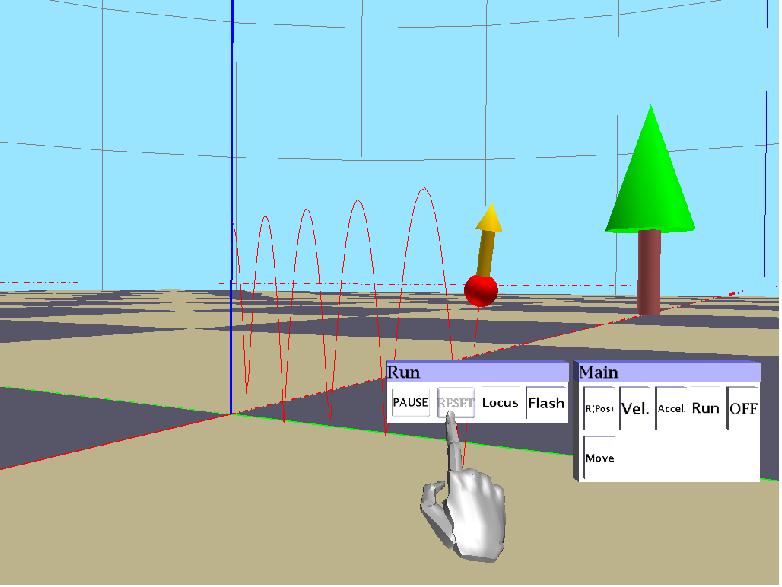 I supervised Mr.
Hashimoto when he did his graduate study, as he was a fourth year
student at the discipline of Natural Science Study in the first year I
came to Kumamoto. After that, I supervised him during his two-year
master's course. I supervised Mr.
Hashimoto when he did his graduate study, as he was a fourth year
student at the discipline of Natural Science Study in the first year I
came to Kumamoto. After that, I supervised him during his two-year
master's course.
Those programs that use virtual environment, most of the time,
need some very special environment in order to run. For this reason,
even if the material is educationally highly effective, in many cases,
it is impossible to run it unless there is a special virtual reality
device. Take immersive environment, for example: when you are in a
square box the size of a few cubic meters where you can have stereo
vision in all directions including top, bottom, left and right (for
example, TEELeX etc), you can feel as if you are in a space
or microscopic space. However, in that case you cannot operate the
keyboard etc. Therefore, in such a VR environment, people often use a
mechanism where you wear a special glove so that your hand is displayed
in the virtual environment. When you move your hand, the hand in the
virtual environment also moves the same way you move your hand. In this
way, you can operate buttons and switches created in the virtual space
indirectly through your hand movement.
However, it is utterly impossible to do such a thing with an
ordinary PC. To solve this problem, Mr. Hashimoto developed a system to
replace this special glove with mouse movement (a sort of device
emulator). In addition, making use of the USB camera driver developed by
Mr. Orita as mentioned above, he extended his development in such a way
that the location of the hand is worked out from the information given
by two USB cameras so that the hand can be displayed in the virtual
space.
Participating remotely though a video link, he presented the results of
his work in English by himself in an international conference, when he
was in the first year of his master's course [1]. In this presentation
he used a demonstration movie [2].
- A. Hashimoto, H.
Nakano, S. Osawa, S. Orita, H. Akiyama, "Development of a Hand
Device Emulation System for Realizing a Virtual Environment on a
Personal Computer by it3d and Java3D", 2nd International Conference on
Emerging Telecommunications Technologies and Applications and the 4th
Conference on Virtual University (ICETA2003), Sept., 11-13, Kosice,
Slovakia (2003).
- A
demonstration movie in the format of Flash Video, MPEG, QiuickTime, MPEG4.
An
example of research & development related to simulation material
(2002-2003)
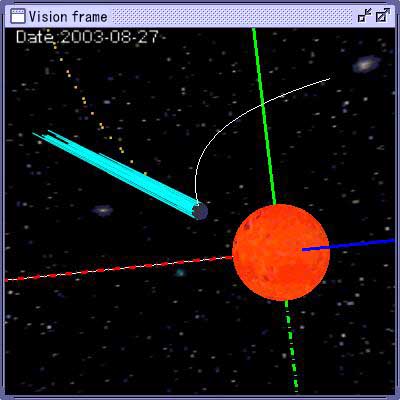 Mr.Orita was one of my
last students when I was at Nagoya University, whom I feel sorry for
because I, his supervisor, moved to Kumamoto University in June just
after he started the first year of his master's study. Although I went
to Nagoya to give lectures during the first year of the master's course,
at the beginning of the second year of his master's course, he had to
move to Kumamoto to study, staying a little less than one year in
Kumamoto. As his original interest was in the area of virtual reality
(VR), he began to develop simulation programs immediately after he
started his first year. By the end of his first year, he had developed a
simulation program in relation to the tail of a comet in Java applet
using Java 3D, which he presented at a conference when he was in the
second year of the master's course [1]. In the second year of his
master's course, he developed a videoconference system with stereovision
using two USB cameras [2]. Mr.Orita was one of my
last students when I was at Nagoya University, whom I feel sorry for
because I, his supervisor, moved to Kumamoto University in June just
after he started the first year of his master's study. Although I went
to Nagoya to give lectures during the first year of the master's course,
at the beginning of the second year of his master's course, he had to
move to Kumamoto to study, staying a little less than one year in
Kumamoto. As his original interest was in the area of virtual reality
(VR), he began to develop simulation programs immediately after he
started his first year. By the end of his first year, he had developed a
simulation program in relation to the tail of a comet in Java applet
using Java 3D, which he presented at a conference when he was in the
second year of the master's course [1]. In the second year of his
master's course, he developed a videoconference system with stereovision
using two USB cameras [2].
- S. Orita, H. Nakano,
K. Tokunaga and Y. Nakamura, “Simulation of the Tail of a Comet Using
Java 3D”, 2003 PC Conference Collection of Papers (Kagoshima
University), 2003 (Japanese only)
- Shinichi Orita,
“Development of Video Conference System Using Multiple 3D Images in a
Virtual Space”, summary of master's thesis, majored in Graduate School
of Human Informatics (reorganized to Graduate School of Information
Science since 2005), Nagoya University, March 2004 (Japanese only)
Currently, I have not
made research works I have supervised in the past publicly available.
The reason for this is that firstly I am not confident enough to
publicize them, and secondly I am too busy to check them to see if they
can be made publicly available. Lastly, please note that many of the
examples I introduced here should be considered better than average.
|